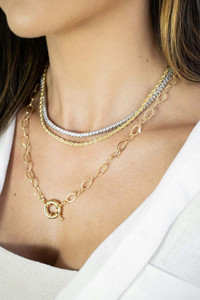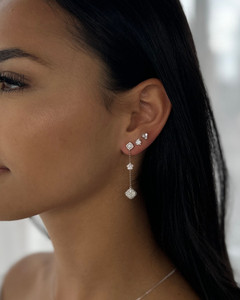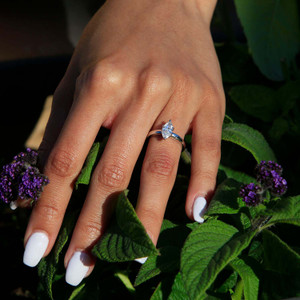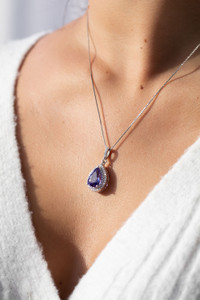The Fascinating World of Lab Grown and Natural Diamonds: Can You Spot the Difference?

In recent years, the jewelry industry has been buzzing with excitement over lab grown diamonds. These remarkable gems have sparked curiosity and debate among consumers and experts alike. But the question on everyone's mind remains: Can you really tell the difference between lab grown and natural diamonds? Let's dive deep into this sparkling topic and uncover the truth behind these precious stones.
The Science Behind the Shine
At their core, both lab grown and natural diamonds are composed of pure carbon. The key difference lies in their origin. Natural diamonds form deep within the Earth over millions of years, while lab grown diamonds are created in controlled environments using advanced technological processes.
Despite their different beginnings, lab grown diamonds share remarkable similarities with their natural counterparts:
- Chemical Composition: Both types of diamonds are made of carbon atoms arranged in a crystal structure.
- Physical Properties: Lab grown and natural diamonds exhibit identical hardness, making them equally durable and scratch-resistant.
- Optical Characteristics: The brilliance, fire, and scintillation that make diamonds so captivating are present in both varieties.
These similarities make it virtually impossible for the average person to distinguish between lab grown and natural diamonds with the naked eye. Even experienced jewelers often struggle to tell them apart without specialized equipment.
The Rise of Lab Grown Diamond Jewelry
The increasing popularity of lab grown diamonds has led to a boom in lab grown diamond jewelry. Consumers are drawn to these gems for several reasons:
- Ethical Considerations: Lab grown diamonds offer a conflict-free alternative to natural diamonds, appealing to socially conscious buyers.
- Environmental Impact: The production of lab grown diamonds typically has a smaller carbon footprint compared to traditional diamond mining.
- Affordability: Lab created diamonds are often more budget-friendly, allowing consumers to get larger or higher-quality stones for their money.
- Consistency: The controlled environment in which lab diamonds are grown results in fewer inclusions and a more consistent appearance.
As a result, many jewelry brands now offer extensive collections of lab diamond jewelry, ranging from stunning engagement rings to elegant everyday pieces.

The Subtle Differences: A Closer Look
While lab grown and natural diamonds may appear identical to the untrained eye, gemologists with specialized training and equipment can detect subtle differences:
- Growth Patterns: Natural diamonds typically form with octahedral crystal structures, while lab grown diamonds may exhibit slightly different growth patterns.
- Inclusions: Natural diamonds often contain inclusions from minerals present during their formation. Lab grown diamonds may have metallic inclusions from the growth process.
- Fluorescence: When exposed to certain types of light, lab grown and natural diamonds can exhibit different fluorescence patterns.
- Identification Marks: Many lab grown diamonds feature a tiny laser inscription on their girdle, invisible to the naked eye but detectable under magnification.
These distinctions are so minute that they require sophisticated gemological tools to observe. Such equipment can detect unique fluorescence patterns and internal characteristics that set lab grown and natural diamonds apart.
The Challenge: Can You Tell Them Apart?
Now that we've explored the science behind these gems, let's put your diamond-spotting skills to the test. Imagine you're presented with a selection of six stunning diamonds, arranged in two rows of three. Your task is to identify which are natural and which are lab grown.
As you examine each sparkling stone, you might find yourself second-guessing every observation. Is that tiny inclusion a sign of natural origin, or could it be a result of the lab growing process? Does one diamond seem to refract light slightly differently, or is it just a trick of the eye?
The truth is, even seasoned professionals often struggle with this challenge when limited to visual inspection alone. The similarities between lab grown and natural diamonds are so striking that it's nearly impossible to differentiate them without specialized equipment.
So, how did you fare in our imaginary test? If you're feeling uncertain, you're not alone. The fact that lab grown and natural diamonds are so similar in appearance is precisely what makes both options appealing to consumers.

The Beauty of Choice in Lab Grown Jewelry
The emergence of lab grown diamonds has expanded the possibilities for stunning jewelry designs. Jewelers now have more flexibility to create pieces that might have been cost-prohibitive with natural diamonds alone. This has led to an explosion of creativity in the world of lab diamond jewelry.
Some popular trends in lab grown diamond jewelry include:
- Statement Pieces: Larger center stones or multiple diamond designs that make a bold impact.
- Colorful Creations: Lab grown colored diamonds in rare hues like blue or pink, often at more accessible price points.
- Innovative Cuts: Unique and intricate diamond cuts that showcase the precision possible with lab grown stones.
- Mixed Metal Designs: Combining different metals with lab grown diamonds for contemporary, eye-catching pieces.
The versatility of lab created diamonds has allowed designers to push boundaries and offer consumers more options than ever before.
The Future of Diamonds: Natural and Lab Grown Coexisting
As the jewelry industry continues to evolve, it's clear that both natural and lab grown diamonds have their place in the market. Each option offers unique benefits that appeal to different consumers:
Natural Diamonds:
- Rich history and tradition
- Perceived rarity and value
- Connection to the earth's natural processes
- Potential for investment value
Lab Grown Diamonds:
- Ethical sourcing guarantees
- Lower environmental impact
- More affordable pricing
- Consistent quality and appearance
Rather than viewing these options as competitors, many in the industry see them as complementary choices that cater to diverse consumer preferences.

Making an Informed Decision
When considering a diamond purchase, whether for an engagement ring or a special piece of jewelry, it's essential to weigh your priorities:
- Budget: Determine how much you're comfortable spending and explore options in both natural and lab grown diamonds within that range.
- Size and Quality: Consider whether you prefer a larger stone with potentially more inclusions or a smaller, higher-quality diamond.
- Ethical Concerns: Research the sourcing practices of natural diamond suppliers and the production methods of lab grown diamond companies.
- Personal Values: Reflect on what the diamond symbolizes to you and which option aligns best with your beliefs.
- Future Plans: Think about long-term factors like potential resale value or passing the piece down as an heirloom.
By carefully considering these factors, you can make a choice that feels right for you, whether it's a natural diamond, a lab grown diamond, or perhaps even a combination of both in a single piece of jewelry.
Caring for Your Diamond: Lab Grown or Natural
Regardless of your choice, proper care is essential to keep your diamond jewelry looking its best:
- Regular Cleaning: Gently clean your diamond jewelry with mild soap and warm water, or use a specialized jewelry cleaner.
- Professional Inspections: Have your pieces checked by a jeweler annually to ensure settings are secure and stones are in good condition.
- Safe Storage: Keep your diamond jewelry in a fabric-lined box or pouch to prevent scratching when not worn.
- Avoid Harsh Chemicals: Remove diamond jewelry before swimming in chlorinated pools or using household cleaning products.
With proper care, both lab grown and natural diamond jewelry can maintain their brilliance for generations to come.
Embracing the Beauty of Both Worlds
As we've explored, the world of diamonds is more diverse and exciting than ever before. The advent of lab grown diamonds has opened up new possibilities for consumers and designers alike, while natural diamonds continue to hold their allure and tradition.
Whether you're drawn to the geological marvel of a natural diamond or the technological achievement of a lab grown stone, remember that the true value of any piece of jewelry lies in its meaning to you. Both options offer exceptional beauty, durability, and the potential to become cherished symbols of love, accomplishment, or personal style.
So the next time you find yourself admiring a stunning diamond, whether in a jewelry store window or on someone's finger, take a moment to appreciate its brilliance. And remember, whether it was formed in the depths of the Earth or created through human ingenuity, its beauty is a testament to the wonders of our world – both natural and technological.
In the end, the choice between lab grown and natural diamonds is deeply personal. By understanding the characteristics, benefits, and considerations of each option, you can make an informed decision that aligns with your values, budget, and desires. Whichever path you choose, you'll be wearing a piece of scientific marvel – a sparkling carbon crystal that captures light and imagination in equal measure.





